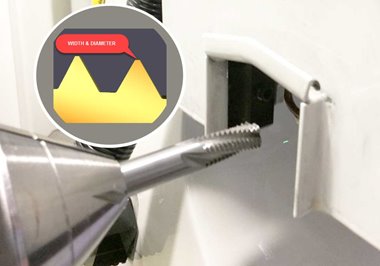E-Sharp News
April 2019
Thomson Mathews gives tips on how to reduce cycle time and scrap by learning how to grind thread mills
Thread mills drastically reduce cycle time and the occurrences of scrap when compared to taps, which makes them desirable when manufacturing large and costly components. I.e. if a tap breaks during the process it’s difficult to remove and rethread on larger components. However, threading a workpiece is by no means is as simple as it sounds.
Thomson Mathew, ANCA Product Manager said: “Tapping tends to be used primarily to make threads in small holes and ranges from 0.5mm to 12mm but sometimes can exceed 100mm in diameter. Threads cut with a tap are not of the same quality as milled threads.”
“Less familiar, even to experienced manufacturing engineers, is thread milling using either solid carbide thread mills or steel holders with indexable inserts. Traditionally, thread milling has been applied primarily to large workpieces. Now, solid carbide thread mills can produce threaded holes as small as 8mm.”

Insert ThreadMill
Everyone can reap the benefits of thread milling – learn how
Through the years, thread milling has evolved, and manufacturers are now using the process to produce strong, exceptional threads in hardened materials up to 68 Rockwell. Some key milestones and benefits of thread milling are:
- Depending on the hole diameter, tapping can be performed either by hand or machine. Thread milling, however, requires use of a machine tool usually with CNC capability.
- Since thread milling uses helical interpolation, it isn’t necessary to have the right hole size because the thread mill will cut the hole larger. Generally, when operators tap, they drill the hole larger than necessary because it is easier. However, in doing so, they could lose part of the thread and reduce its overall strength.
- Thread milling achieves a better thread quality than tapping because the threads are being properly machined with the clearance needed to evacuate the chip, using a tool that is smaller than the threads themselves. Tapping uses a tool the same size as the thread, forcing the chip through the thread form for evacuation.
- Thread milling is easier on the machine tool because it requires lower cutting forces than tapping.
- It’s common for small taps to break during the tapping process. Once it is broken, removing the remnants of the broken tap from the hole can be time consuming, but often, a broken tap results in a scrapped part.
- Threadmills can produce either a right- or left-handed threads using the same tooling.

Thomson continues: “While thread milling is a practical solution for threading large holes, it demands a careful and deliberate approach. First, it requires CNC machines with at least three-axes for helical interpolation. Second, either the machine operator or manufacturing engineer must be able to write and understand the necessary computer program for thread milling or have access to thread milling software or CAM programming software that includes thread milling options.”
“The depth of the thread is an important consideration as well. Usually depth is no more than one and a half times the diameter of the hole. The reason being is that the longer the milling tool, the more chance it can experience deflection, which can create inaccuracies in the thread.”
18 апреля 2019